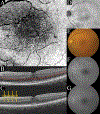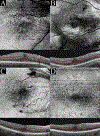FINGERPRINT SIGN OF THE HENLE FIBER LAYER
- PMID: 32604343
- PMCID: PMC7959252
- DOI: 10.1097/IAE.0000000000002875
FINGERPRINT SIGN OF THE HENLE FIBER LAYER
Abstract
Purpose: To describe the appearance of concentric, fingerprint-like waves within the Henle fiber layer (HFL) using en face optical coherence tomography in patients with tractional pathologies of the retina.
Methods: Retrospective analysis of six eyes of six patients imaged by optical coherence tomography with volumetric slabs positioned at the level of the HFL.
Results: Optical coherence tomography data from six patients with tractional vitreoretinal pathology were reviewed. Concentric, fingerprint-like microwaves were visualized through en face optical coherence tomography in all six study eyes at the level of the HFL. This finding resembled the finding of HFL waves previously noted histopathologically from force exerted on this layer.
Conclusion: In retinal pathologies in which specific physical forces act on the retina, volumetric optical coherence tomography may permit visualization of en face concentric, fingerprint-like hyperreflective rings within the HFL. This "fingerprint sign" may represent a biomechanical consequence of traction on the retina and allow clinical decision making based on improved recognition of the existence of such traction.
Figures



References
Publication types
MeSH terms
Grants and funding
LinkOut - more resources
Full Text Sources
Research Materials

